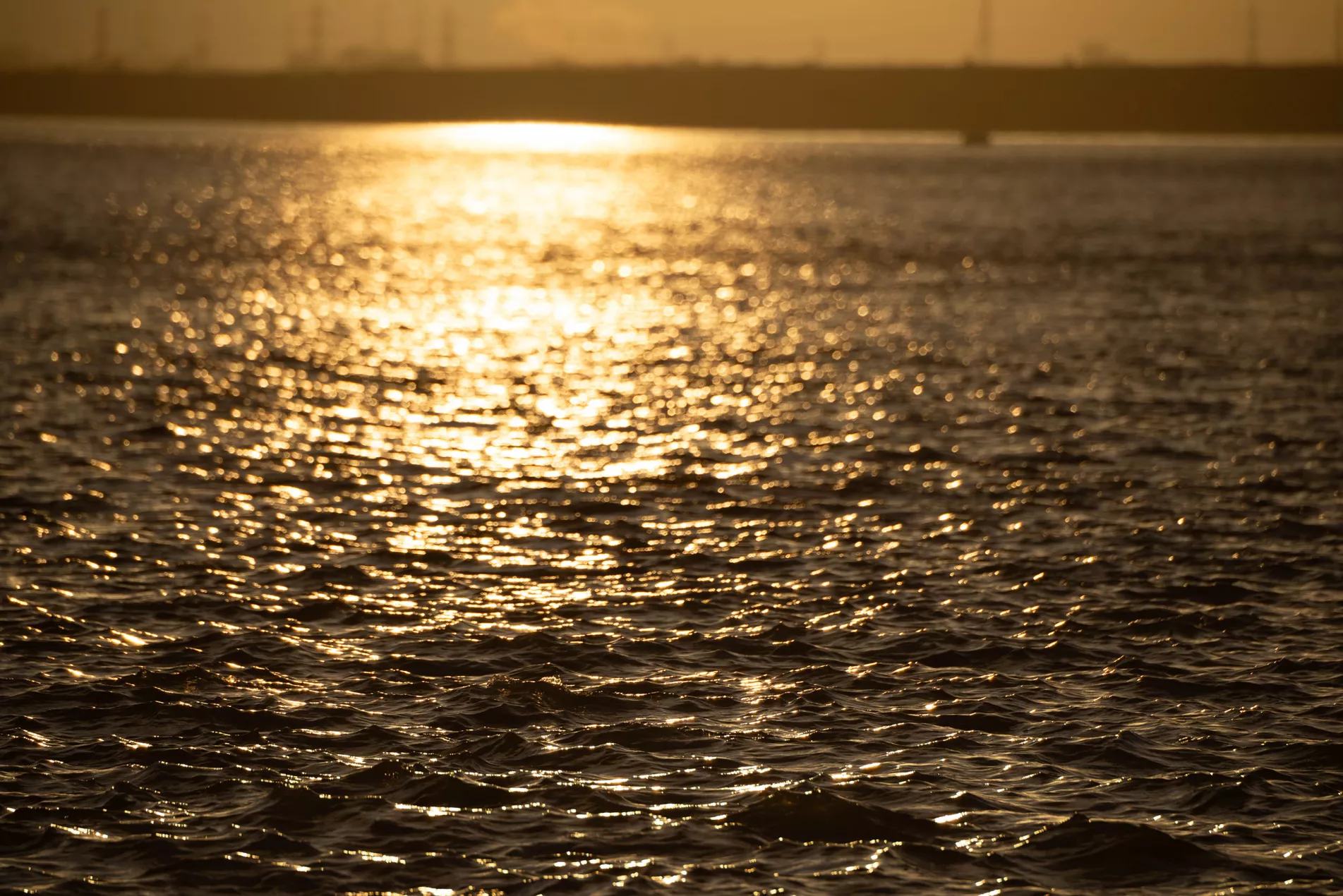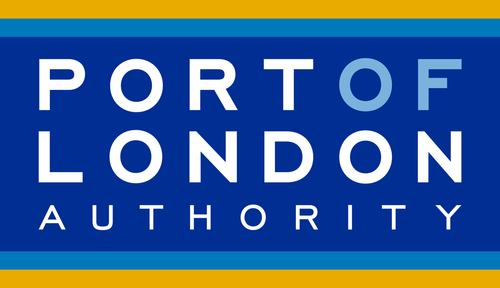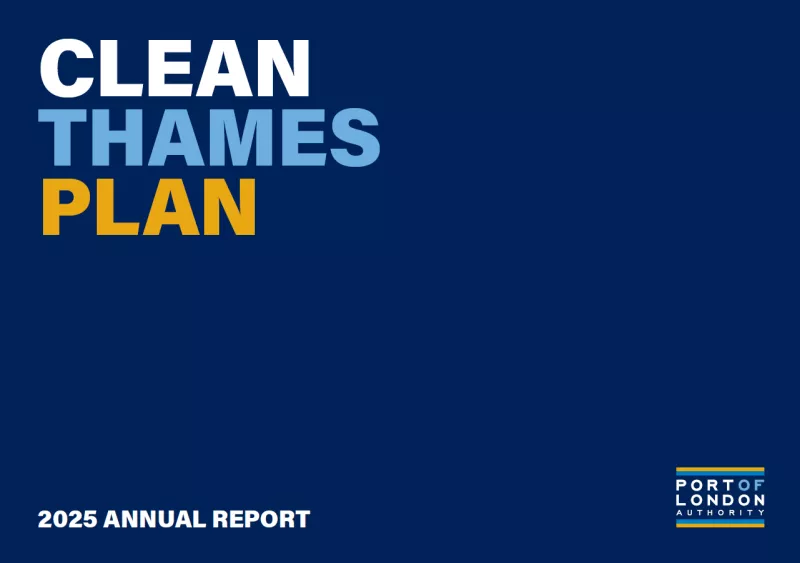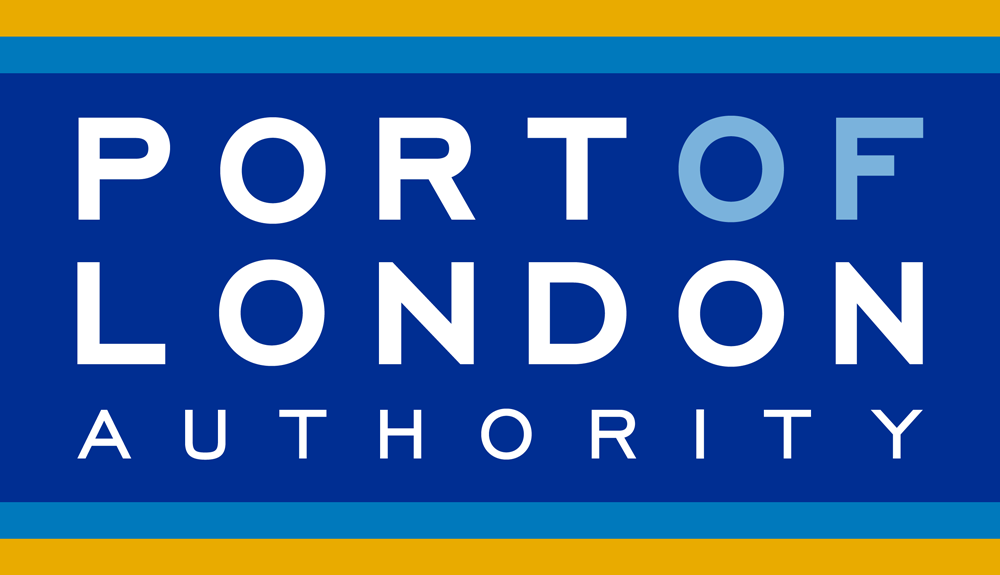Live Tides
NOTICES TO MARINERS
Charts & Surveys
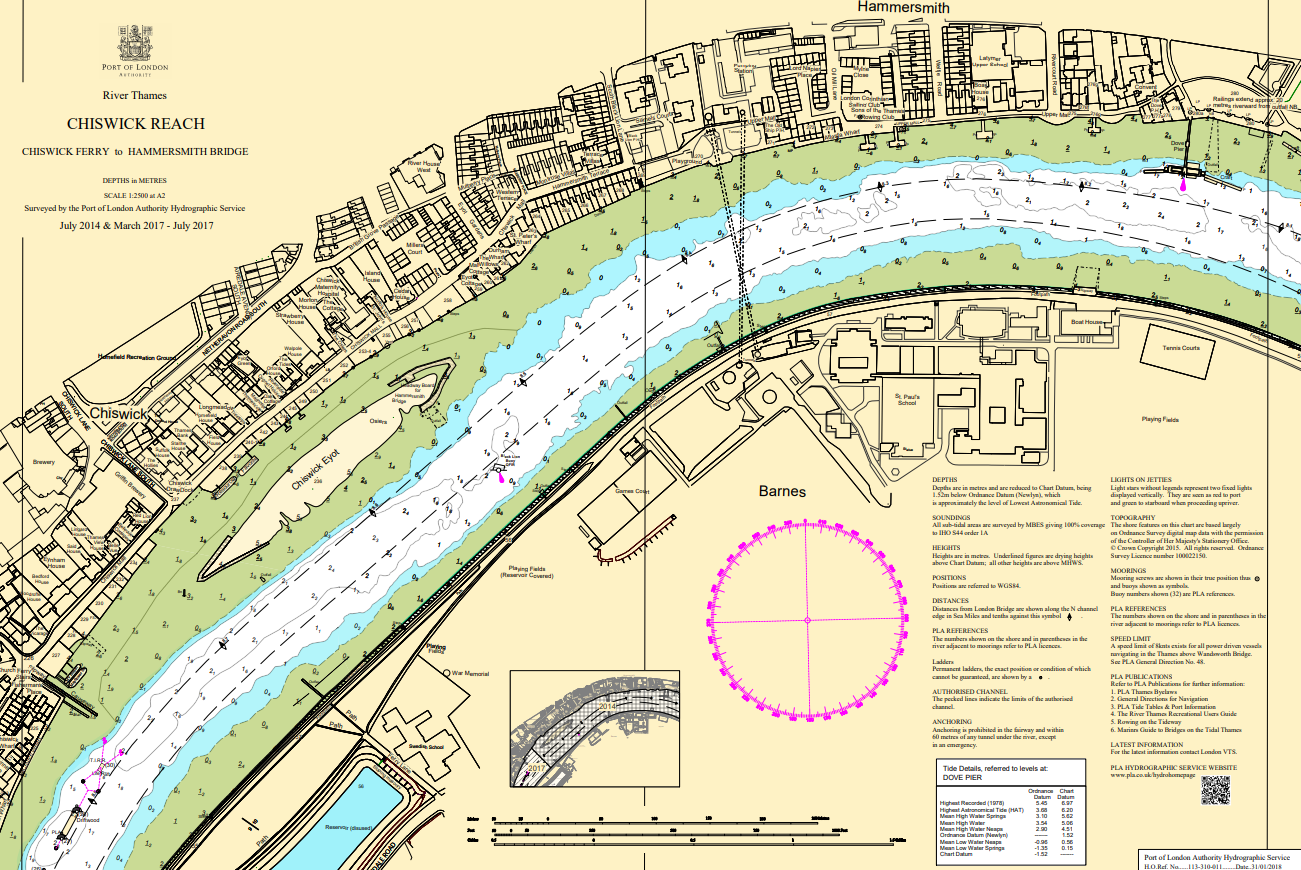
Incident reporting
Life-threatening emergencies on the river:
Call 999 and ask for the Coastguard
For near miss, safety observations and incident reporting click below
Tidal Thames Water Safety Forum
Progress Report May 2019 - May 2023
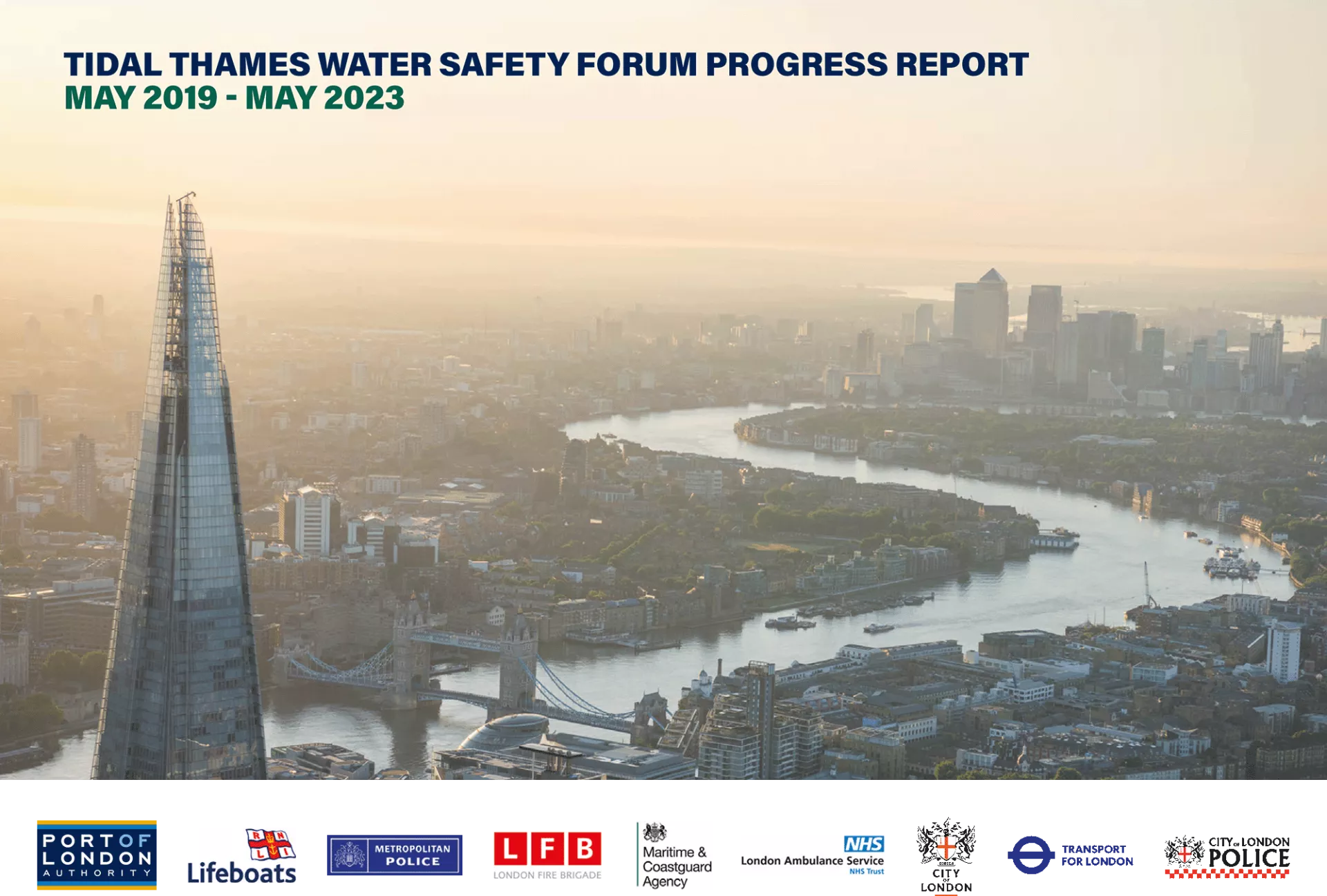
In May 2019, the Royal National Lifeboat Institute (RNLI), London Fire Brigade, HM Coastguard, Metropolitan Police Marine Unit, London Ambulance Service and the Port of London Authority came together to establish a water safety forum and publish a drowning prevention strategy for the tidal Thames. As partners, they work together to reduce the number of people who drown in the tidal Thames, either accidentally or deliberately.
Within two years, the forum expanded to include the City of London Corporation, Transport for London and the City of London Police. A second forum was established for Kent and Essex, bringing similar parties together to focus on drowning prevention in the lower Thames and Estuary.
Over the past four years the Tidal Thames Water Safety Forum (TTWSF) has worked on key projects and campaigns to improve safety along the river and raise awareness of the issues on the tidal Thames. A two year progress report was published in May 2021 and is available to view here. This report summarises the work the forum has completed over the past four years.
Objectives
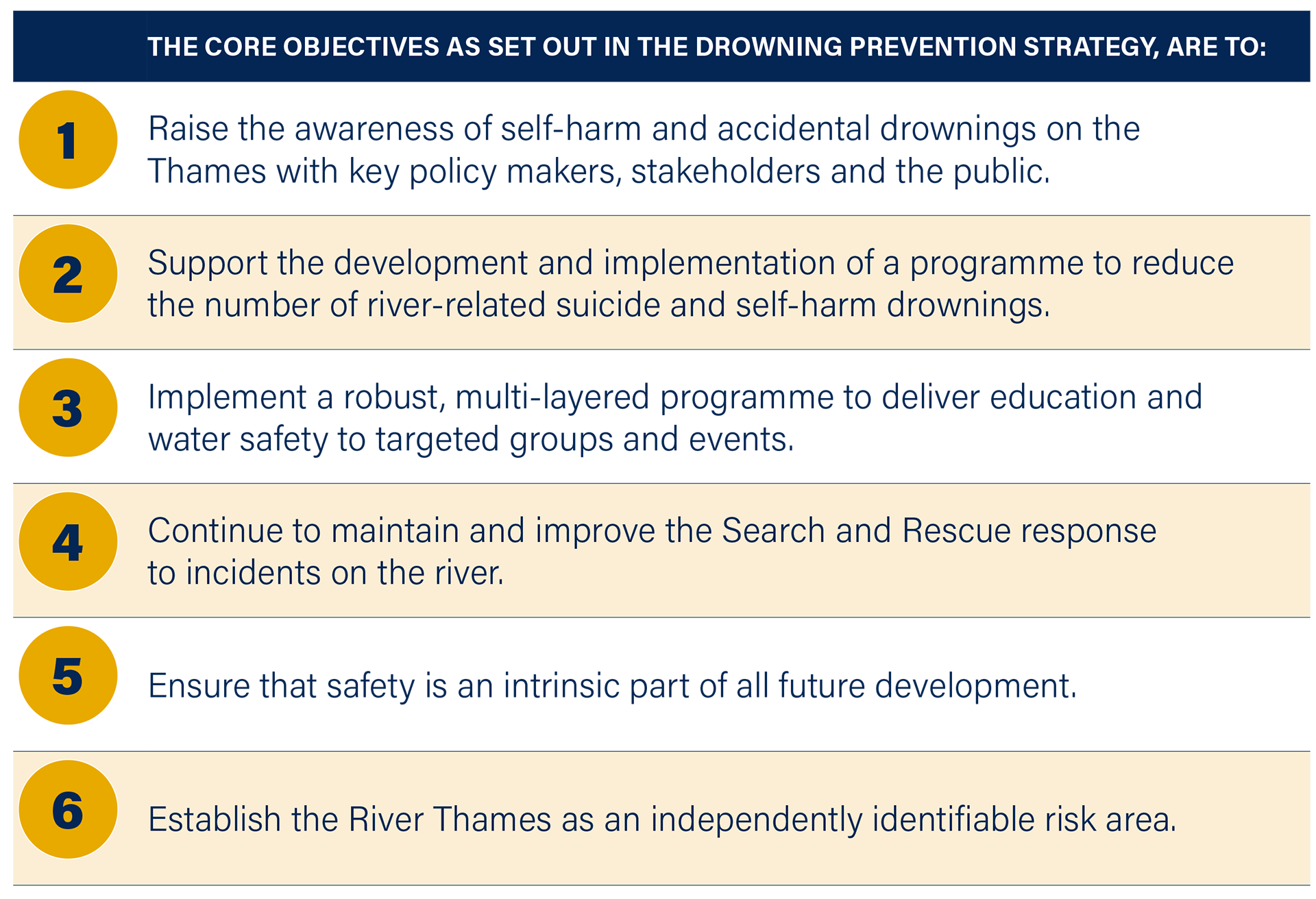
Statistics
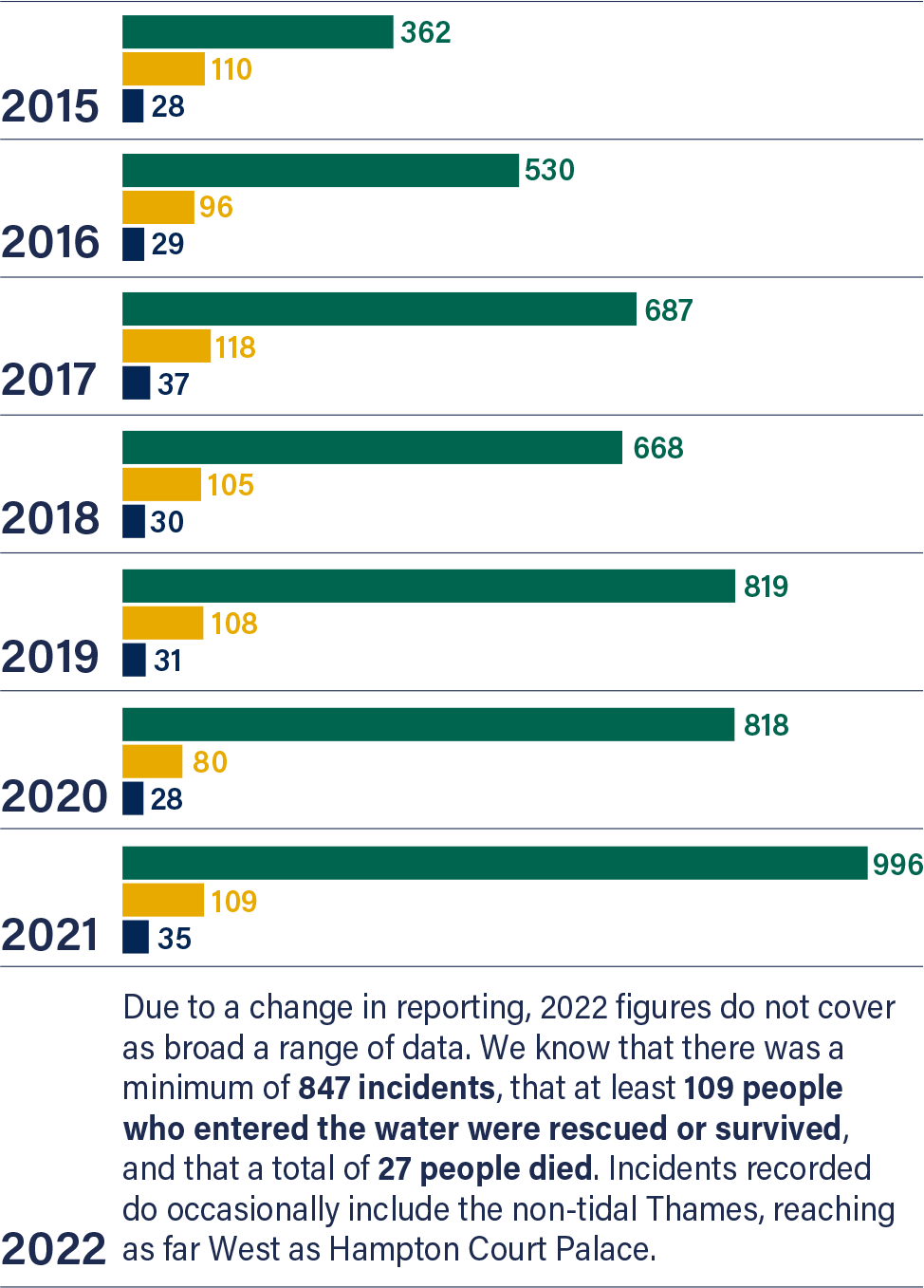

Objective 1
Raise the awareness of self-harm and accidental drownings on the Thames with key policy makers, stakeholders and the public.
PUBLIC RESCUE EQUIPMENT
The extent to which public rescue equipment is managed along the Thames varies between locations. When new developments are proposed near to the River the PLA makes representations to local planning authorities to secure the provision and maintenance of lifesaving equipment such as lifebuoys, grab chains and ladders by developers. The PLA also secures the provision and maintenance of life saving equipment through its river works licensing process.
The PLA conducted an extensive mapping exercise to identify locations of public rescue equipment and share this data through a publicly accessible GIS map. The aim is to work in conjunction with local authorities and landowners, to ensure that missing or defective equipment is replaced or repaired promptly. In total, 430,157m of river frontage was mapped.
A letter was sent from the forum to all local authorities along the River Thames in early 2023, highlighting best practice in the provision of public rescue equipment and providing key contacts and training options to support water safety. London Fire Brigade also contacted all boroughs, not just those on the Thames, reinforcing this message and encouraging local authorities to work with them to install appropriate public rescue equipment. See link to GIS map.
NATIONAL WATER SAFETY FORUM
The National Water Safety Forum is a UK-focused voluntary network, working together in order to reduce water-related deaths and associated harm. They have a calendar of water safety campaigns and events throughout the year, all of which are fully supported by members of the TTWSF through their individual social media channels, and through use of a shared regional hashtag #SaferThames. The Chair of the TTWSF is a member of the National Water Safety Forum inland waterways advisory group, which meets twice a year to share learning across the sector. Several of the TTWSF partners sit on other water safety advisory groups and attended the national water safety conference in Cardiff 2023.
TIME TO TALK
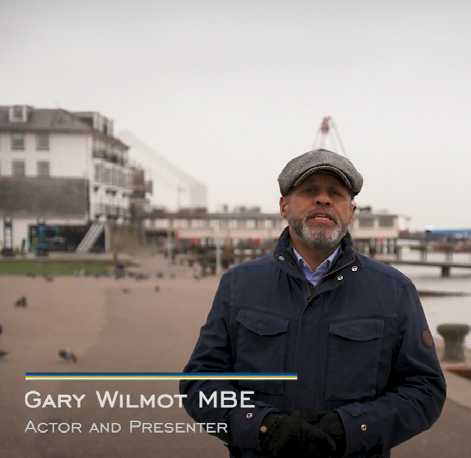 In 2008, Neil Laybourn stopped a stranger from taking his own life on a bridge in central London. This stranger was Jonny Benjamin MBE who, years later, found Neil and thanked him for saving his life. Since then, both Neil and Jonny have become leading advocates for mental health and co-founded the charity Beyond.
In 2008, Neil Laybourn stopped a stranger from taking his own life on a bridge in central London. This stranger was Jonny Benjamin MBE who, years later, found Neil and thanked him for saving his life. Since then, both Neil and Jonny have become leading advocates for mental health and co-founded the charity Beyond.
Neil worked with the PLA to produce a film, which was released on Time to Talk day (4 February 2021), encouraging the public, particularly men, to talk more openly about their mental health. It has had over 1,600 views to date. The film highlights the difference employers can make through having mental health first aiders, how colleagues can support one another during difficult times, and how the kindness of a stranger can make the difference between life or death.
Objective 2
Support the development and implementation of a programme to reduce the number of river-related suicide and self-harm drownings.
MENTAL HEALTH STREET TRIAGE
The emergency services are called to attend situations where individuals are threatening to take their own lives. Within the City of London, there are trained mental health practitioners on standby to accompany police officers when alerted to people in distress near the river. The practitioners are able to access digital care records at the scene and, through understanding the history of the individual, assess and treat the people involved more effectively at the scene and reduce repeat presentations.
In 2022, the City of London Corporation increased the number of hours of provision of the mental health street triage team, which supports individuals in crisis and supports the emergency service staff.
BRIDGE WATCH
Members of the public can be key to highlighting safety issues on the river. They might be the first to witness an incident and call 999, to flag something that doesn’t look right, or directly approach someone if they look as though they are in distress.
When researching suicide prevention programmes, technology and deterrents the TTWSF looked to learn from other areas known as suicide locations. Two intervention programmes came to the fore; Wexford Marine Watch and the Beachy Head chaplaincy team. Both programmes have teams of volunteers patrolling locations known to be high risk areas and have successfully intervened and helped people in crisis, saving lives. Emulating these programmes, Bridge Watch aims to provide a physical presence of teams of volunteers patrolling areas on and around the bridges of London, engaging with anybody that indicates intent to enter the water, or who might not be behaving safely. Christian-based charity Ascension Trust stepped up as a delivery partner to run this programme, and secured support for the roll out of Bridge Watch, thanks to funding from Bridge House Estates Trust. Once the volunteer manager and volunteers are recruited, the programme will roll out across the five City of London bridges.
GOODGYM
Thank you to GoodGym who, prior to the creation of Bridge Watch, responded to a request for help from the TTWSF during Covid lockdowns. Lockdown meant that streets and bridges on the Thames were very quiet without the usual footfall of pedestrians. Responding to a call to action for volunteers to patrol the riverside, GoodGym incorporated the Thames into their ‘Mission Runs’. Volunteers combined exercise with looking out for people in distress and over 70 mission runs were completed in February and March 2021. Although nobody came to the attention of the volunteers, it was reassuring to see that members of the public would volunteer to patrol the river.
Julia Shmotkina, GoodGym group operations, said: “We are really pleased to have supported the Safer Thames campaign through running, cycling, or walking by the Thames. Our mission is to combine doing good whilst getting fit, and I am very proud with the response of GoodGym members during the COVID-19 pandemic.”
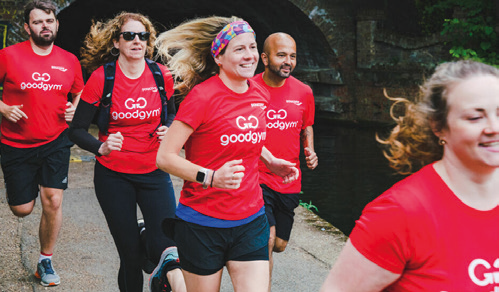
TECHNOLOGY
There are five bridges in the City of London which provide essential crossings over the Thames. They are also a destination for tourists, and historic landmarks in British culture - several of the bridges are also listed structures.
The City of London Corporation and City of London Police work closely together on a wide-ranging public protection strategy including supporting vulnerable people presenting on City bridges. The Secure City Programme (SCP) is working to overhaul the City of London Police CCTV infrastructure and provide step-change improvements to situational awareness and emergency response capability. As part of the programme, SCP is in the process of assessing the effectiveness of a variety of technologies in order to improve situational awareness for the Police and other responders to support vulnerable people.
The application of technology in the City bridges environment is challenging and there are no straightforward examples of similar work being done elsewhere. The team have conducted a number of tests on a range of technologies, both within a controlled marine environment and on the River Thames, and evaluation of the findings continues. The next phase, scheduled to commence in Autumn 2023, will be to give recommendations for implementation.
THAMES SKILLS ACADEMY
The Thames Skills Academy (TSA) is a not-for-profit employer-led organisation established to raise safety standards and improve skills for everyone working on and alongside the Thames. TSA were awarded the Princess Royal training Award by the City & Guilds Foundation in 2021 for their outstanding skills and training development. The TSA work closely with the PLA to improve safety on the river Thames and were concerned to hear that many people living and working on or alongside the river come into contact with people in crisis. Caring for people’s skills development is at the core of the TSA, and they are very supportive of the TTWSF and support the delivery of the Drowning Prevention Strategy.
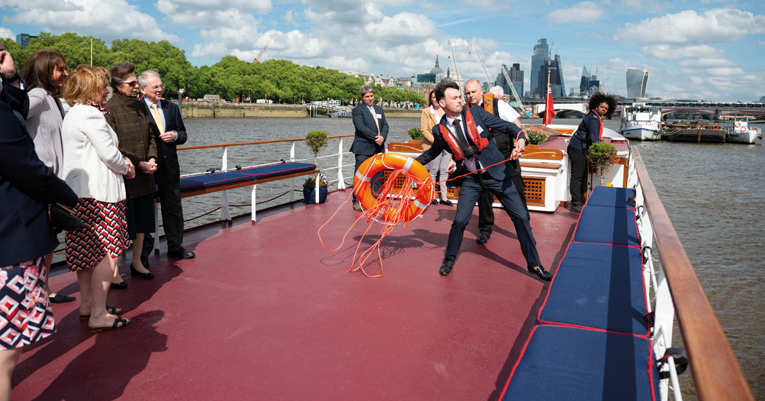
To help combat incidents on the river, the TSA have taken the lead in developing two excellent training courses, one on personal safety and the other on suicide intervention:
Suicide Intervention training
The TSA partnered with The Listening Place to create a half-day course focused on suicide intervention. The course equips people with the skills and confidence to initiate and manage a conversation with someone in distress and, where appropriate, connects them with further support. The TSA intend to support the rollout of this training over the next two years, thanks to funding from The Fishmongers’ Company, equipping over 300 people with the skills to support someone in distress.
Objective 3
Implement a robust, multi-layered programme to deliver education and water safety to targeted groups and events.
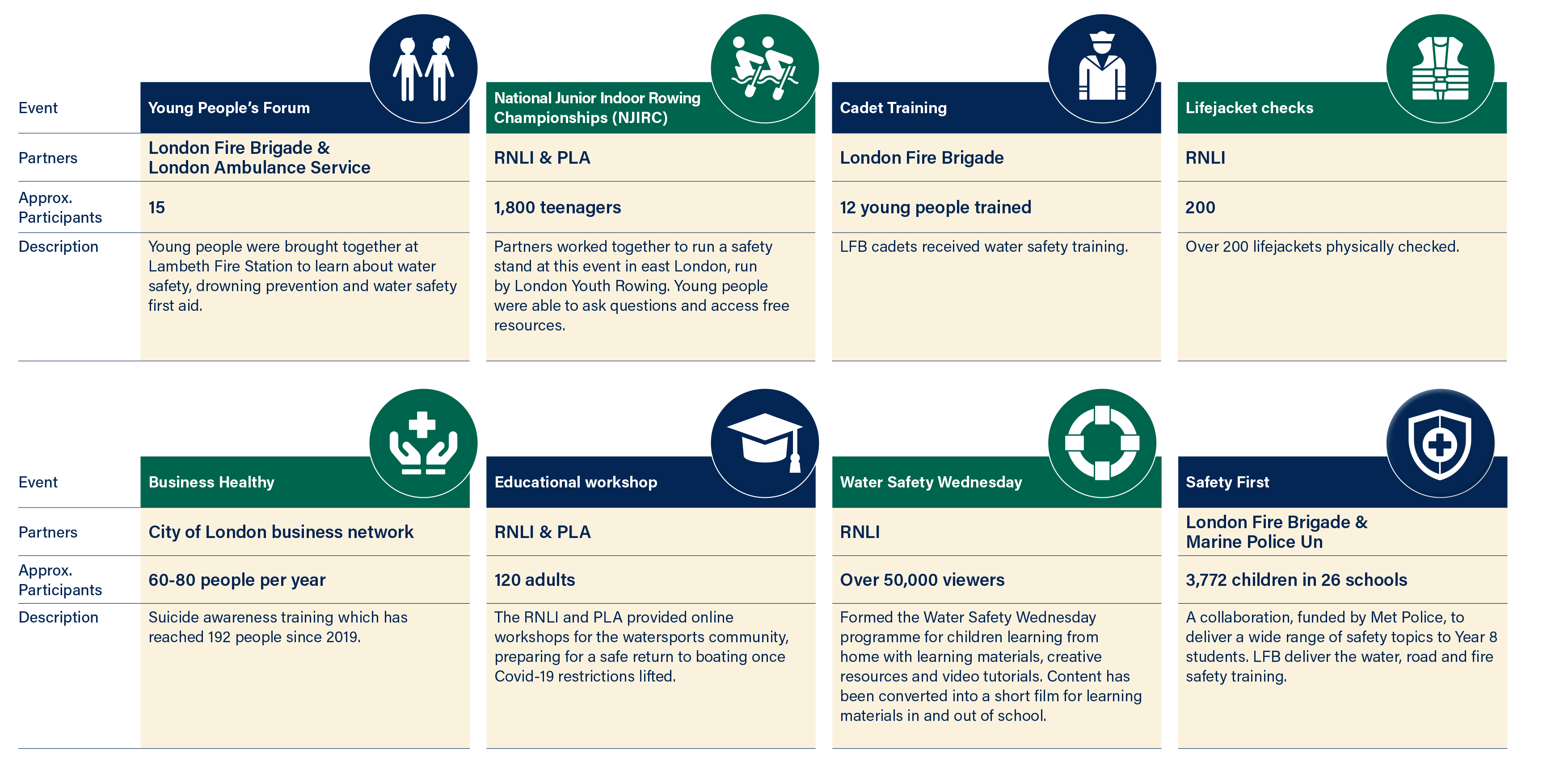
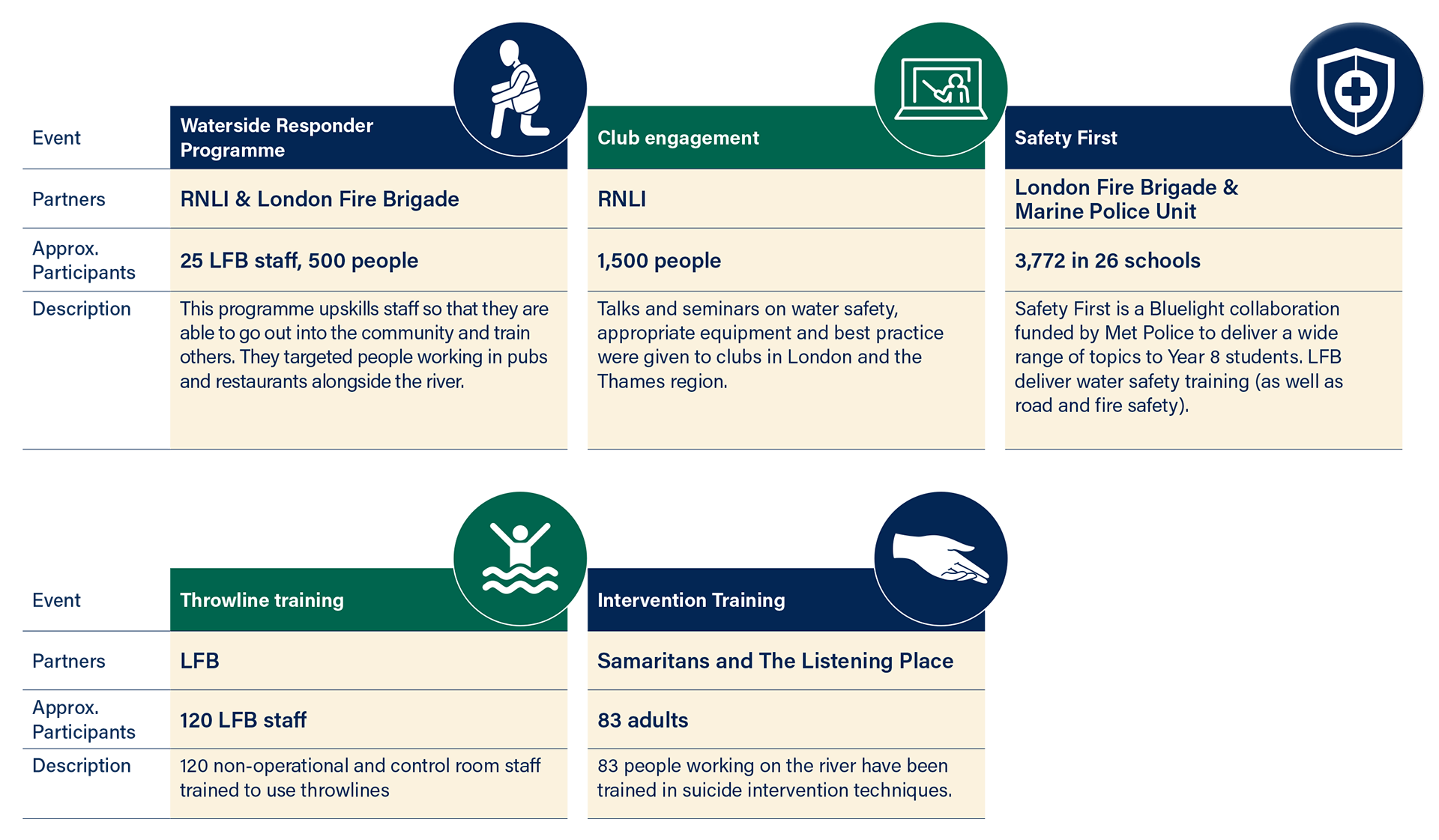
SAFE SPORT
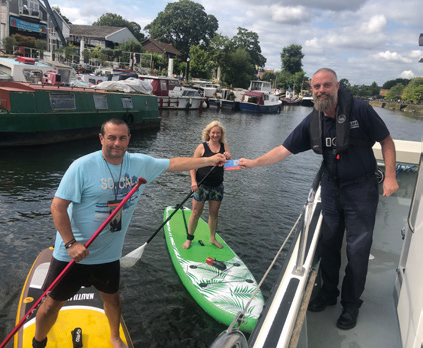 Equipment for the increasingly popular sport of stand-up paddleboarding (SUP) is often sold without any accompanying safety advice. In response to a near-miss incident in Richmond, the PLA worked with delivery partners and British Canoeing to promote messaging on the appropriate use of leashes. Quick release waist leashes are the only suitable leash for tidal water, ankle leashes are not safe.
Equipment for the increasingly popular sport of stand-up paddleboarding (SUP) is often sold without any accompanying safety advice. In response to a near-miss incident in Richmond, the PLA worked with delivery partners and British Canoeing to promote messaging on the appropriate use of leashes. Quick release waist leashes are the only suitable leash for tidal water, ankle leashes are not safe.
Crew on the PLA’s patrol boats regularly give out safety education advice to members of the public, and safety signs have been installed at popular paddling locations, encouraging river users to educate themselves on the river, correct equipment and clothing, and rules of navigation.
Objective 4
Continue to maintain and improve the Search and Rescue response to incidents on the river.
Coordinating search and rescue on the river, HM Coastguard work to ensure response times are as quick as possible. This is achieved through regular inter-agency debriefs and collaboration between partners and the regular review of emerging technology to ensure they are as effective as possible.
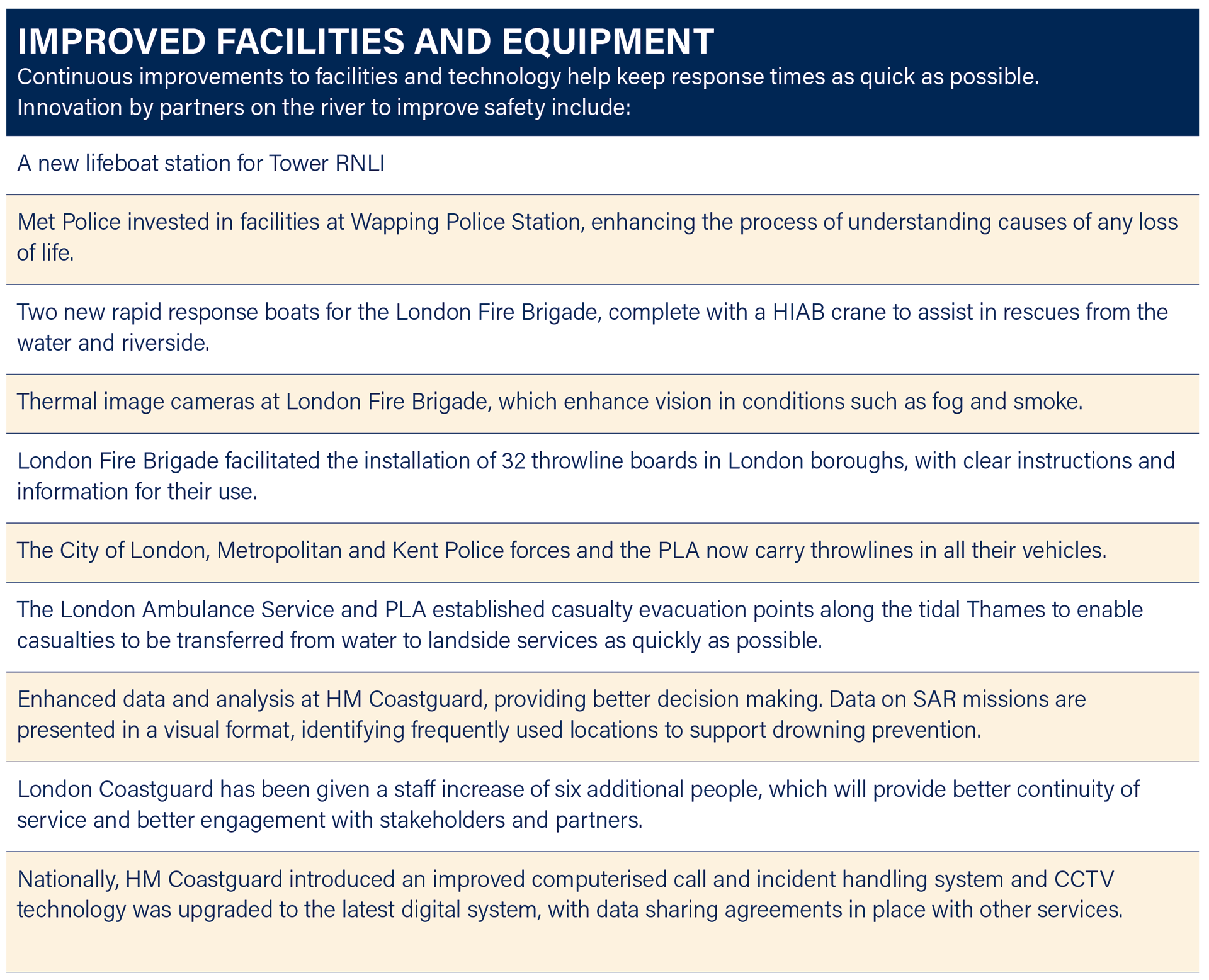
Objective 5
Ensure that safety is an intrinsic part of all future development.
RIVERSIDE PERSONAL SAFETY COURSE
The Thames Skills Academy developed a one-day experiential course which provides an overview of the potential dangers of working on or near water. The course offers practical tips to help people stay safe, should they or a colleague fall into the water. It is designed for people working on or alongside water and more than 1500 people across 60 companies have been trained so far. The aim for this training is that it is undertaken by everyone working on and alongside the Thames.
A SAFER RIVERSIDE
A Safer Riverside is a guidance document for riverside landowners, setting out expectations for water safety within planning applications. It gives specific consideration to bridges, riverside edges, piers and jetties.
Lucy Owen, PLA deputy director of planning and development, said: “Combining insight from multiple areas of expertise is the best way to make the river safer. This publication represents the consolidation of knowledge from all the relevant experts on how developers and planners can make the tidal Thames a safer place. We look forward to seeing it implemented within applications for a river works licence.”
Recommendations in the guide include adequate lighting and protected edges, to make accidental entries into the water less likely, and the installation and maintenance of public rescue equipment, such as grab chains and lifebuoys.
RIVERSIDE COMMUNITY WATER SAFETY
London’s population continues to grow, with more than ten million residents expected in the city by 2041. Launched in Drowning Prevention Week, our Riverside Community Water Safety Guide aims to educates those new to living or working by the tidal Thames. It advises on the dangers of the water, explains what to do in an emergency, and highlights where to find more information on how to enjoy the water safely.
EVENT ORGANISER GUIDANCE
As well as the written guidance for those organising an event on the tidal Thames, the PLA harbour master team provide their expertise to many organisations looking to run events on the river. Where notified and necessary, TTWSF partners attend events, expanding supervision along the tidal Thames.

Objective 6
Establish the River Thames as an independently identifiable risk area.
The Thames is now established as its own risk area in London via the Thames Resilience Panel. The panel meets twice a year providing an opportunity for members to meet their requirements under the Civil Contingencies Act, to cooperate and coordinate in relation to cross-border incidents related to the river Thames.
The top 11 risks have been identified, including self-harm drowning and accidental drowning, and the panel is working with its partners who include the RNLI, HM Coastguard, Metropolitan Police Service, London Fire Brigade, London Ambulance Service and Local Authorities, in assessing these risks.
WE ARE COMMITTED TO REDUCING THE NUMBER OF PEOPLE WHO DROWN IN THE TIDAL THAMES.
For more information on the work of the Tidal Thames Water Safety Forum please visit https://pla.co.uk/watersafety
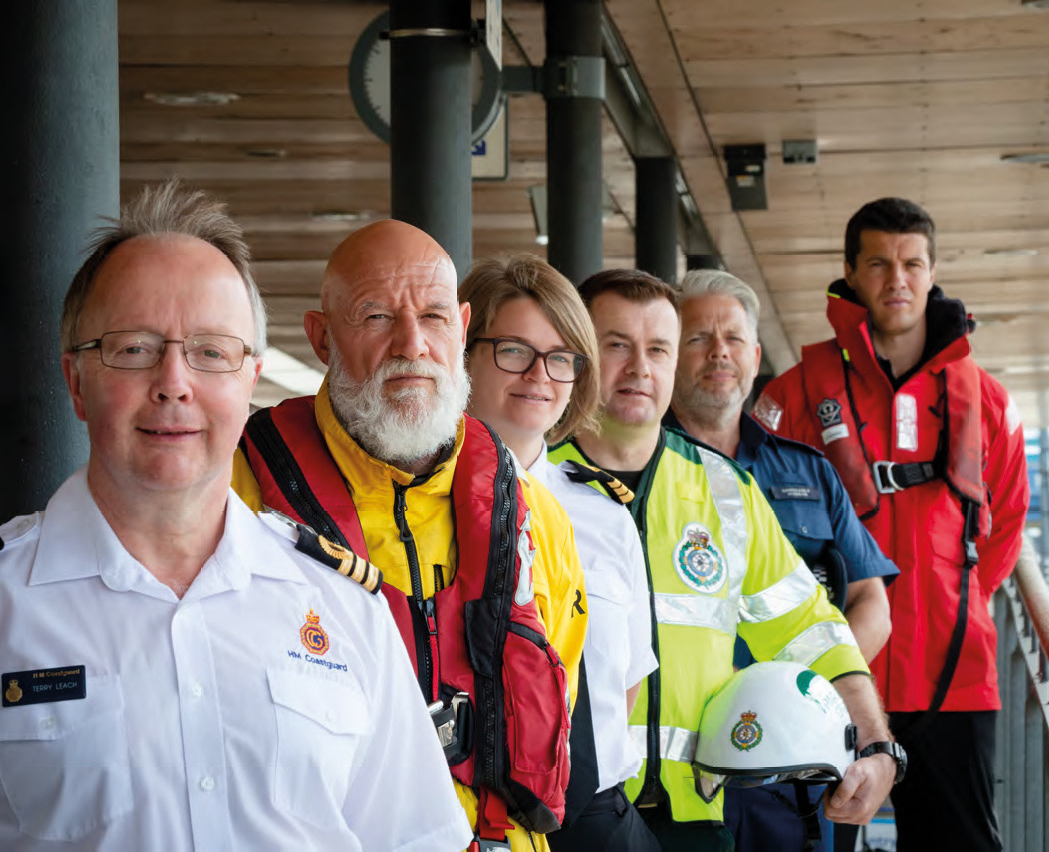
Discover
